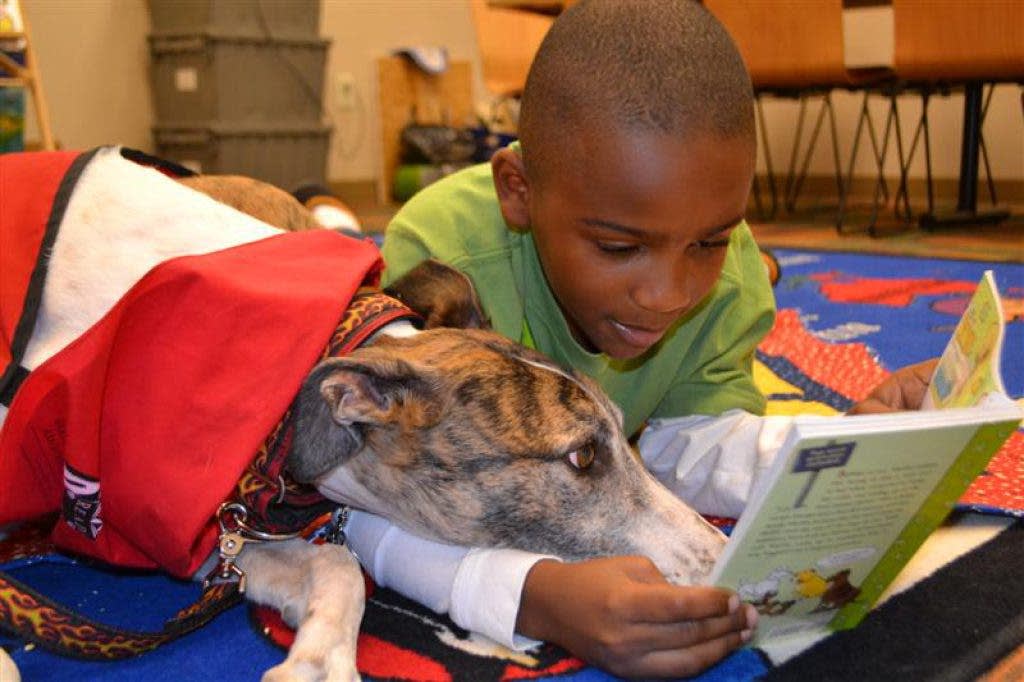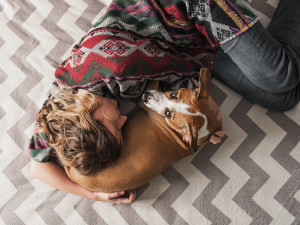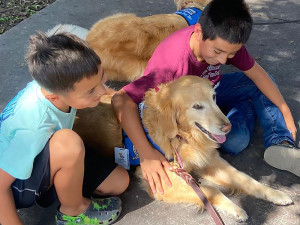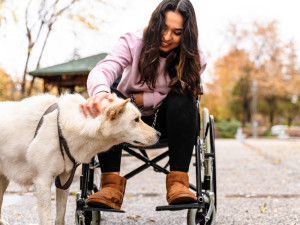5 Places Where Therapy Dogs Do Their Best Work
At airports, hospitals, schools, and more, therapy dogs make things better.
Therapy animals make the world a better place. I know that firsthand. I’ve done a lot of therapy-dog visits with my dog Maggie. We’ve even traveled to other states to volunteer. I can honestly say those were some of our favorite times together. But as a dog trainer, I see a lot of miscommunication and misunderstanding about exactly what a therapy dog is — and how exactly they can help people.
So, what is a therapy dog and where can you bring yours?
Therapy-dog work is a commitment for both the dog and the handler. Not every dog would enjoy being a therapy dog, just like not every dog wants to participate in agility or sheep herding. But if your dog loves attention and affection, and they can remain calm with new people in unfamiliar surroundings, therapy work may be something you’d be interested in doing together.
Trick question: All dogs are perfect! But find out which type is the best fit for you.
Here are some places — or scenarios — where you might consider bringing your therapy dog.
Care and Medical Facilities
The best-known venues for therapy dogs are hospitals and nursing homes, many of which have long-standing programs for therapy animals. To a dog, though, these two institutions can represent very different working environments. At hospitals, you generally go from room to room, visiting patients who’d like to get a visit from a therapy animal. In nursing homes, you might stay in common areas greeting the residents, though some will have you go room to room. Dogs usually work for one to two hours in a session; this is a lot, and your dog will be exhausted from all the meeting and greeting.
How much do you spend on your pet per year?
Airports
In recent years, there’s been much interest in bringing therapy animals to a variety of settings to help people relax and de-stress. Airportsopens in new tab, for example, have been attempting to alleviate the stress of travel by hosting therapy dogs to socialize with travelers who missed their flights, have been slapped with a long delay, or just need some extra love on a long day as they get from A to B.
After Traumatic Events
Therapy dogs are also brought in after tragedies, such as natural disasters, school shootings, or accidents that result in fatalities. Dogs provide healing and comfort in these difficult times and can help ease the pain of loss. As Kinship covered last fall, therapy dogs came to Uvalde, Texas to comfort students in the town, following the deadly shooting at Robb Elementary last May.
“It’s an amazing transformation of children sometimes,” Dr. Thomas Demaria, PhD, a consultant for the National Center for School crisis and Bereavement, told Kinship at the time. “What’s scary is the violence is perpetrated by a human person. Animals — especially dogs — have the capacity to approach children in a safe, comforting way, where they don’t feel alone anymore.”
Helping Domestic Violence Survivors
One of the more interesting places I’ve worked with my dog Maggie was at a safe house for women and children. We went to the group therapy session with the kids. They got to pet Maggie, and I was asked to share stories about Maggie and me that they could relate to. I told them how Maggie doesn’t just bite someone if she’s mad; instead, she may growl or walk away. Many of these kids had never had a dog, had never touched a dog or been kissed by a dog. We all got to learn together, and it was a really special and emotional time each week.
Schools
Schools will engage therapy dogs to support children with social and emotional learning. Studies have shown that having therapy animals results in increased attendance, improved problem solving, and lowered stress levels. Therapy dogs also take part in reading programs, where the company of a dog — a non-judgmental friend — has shown to increase reading skillsopens in new tab by about 12 percent.
In the Courtroom
Therapy dogs are also having their day in court. Child witnesses are often very nervous about speaking in court; the presence of therapy dogs can ease their fears. Check out Courthouse Dogs Foundation opens in new tab for more info on why these dogs are often helpful in these spaces.
If you’re interested in a certain type of therapy work, consider reaching out to a facility near you and asking if they work with a specific part of the therapy-dog community. Just a note that hospitals often partner with a therapy service, and you��’ll have to register with that service (and meet their requirements) to volunteer at that hospital.
Therapy dogs are not service dogs or ESAs.
It’s also important to keep in mind that therapy dogs are not the same as other types of service dogs. Therapy dogs have the job of giving comfort to others, which often involves remaining calm while being petted and loved on. These dogs are very well-behaved and trained. I’ve seen therapy dogs make such a difference for people. I’ve watched as they help patients who haven’t spoken in weeks (suddenly they start sharing stories about their past dog!).
Therapy dogs are different from service dogs; they don’t have public access rights, which means a therapy dog can’t go to a restaurant, a hotel or other non-pet friendly establishments, unless they’re on an official therapy visit. Unlike a service dog, therapy dogs aren’t protected under the Americans with Disabilities Actopens in new tab (ADA).
There’s another category of therapeutic pet called emotional support animals (ESAs). These animals are not required to have any special training; they are simply supportive to their owners by being there as a companion. Like therapy dogs, ESAa don’t have public access rights to non-pet friendly establishments. When working with your therapy dog, it’s important to know your (and your dog’s) rights when it comes to where you can bring them and with whom they can work. Here is more informationopens in new tab on therapy dogs under the ADA.
Regardless of how (and where) you work with therapy dogs, I know you’ll find it rewarding, and well, therapeutic.





